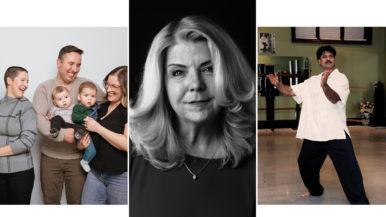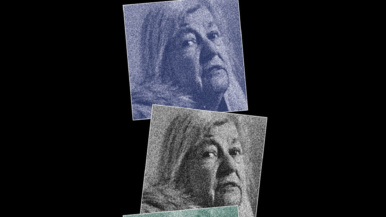“I worked as an ER nurse for 40 years. Covid changed me in profound ways”

Mira Gandhi started her nursing career at Humber River Regional Hospital just over 40 years ago, in February of 1982. She had been planning to retire in late 2020, but when the pandemic hit, she changed her mind. Here, she tells us why she decided to keep working through Covid, and reflects on how much the nursing profession has changed.
—As told to Isabel Slone
“It had always been my plan to retire in December of 2020, when I turned 65. It wasn’t that I needed to retire—I’m in good health and I feel much younger than I am—it just seemed silly to continue working when there are plenty of other things keeping me busy, like spending time with my husband and our three adult children, and the home renovations I’ve been putting off for the past 15 years. I thought, Why keep working if I don’t have to?
“The pandemic upended those plans. We first heard rumblings about a virus overseas in January of 2020. No one at the hospital really knew what was happening. It sounded like pneumonia, and we didn’t think it would be too serious. Then we saw what was happening abroad, and our alarm bells started going off. Soon, we were lining up at the beginning of each shift to get our ration of three masks and one face shield, which was meant to last us for a few days. As fear spread among the public, we had to start hiding our PPE because people would come into the hospital and steal it. That was when I knew we were in for something major.
“I live with my in-laws, who have medical problems. Every day when I got home from work, I’d throw my clothing into the laundry and shower before interacting with anyone. I would decide whether or not to sleep in the same bed as my husband based on how many Covid-positive patients I had cared for that day, and how sick they were. Sometimes I knew that a patient I was caring for had Covid, so I took extra precautions, but other times I would discover that a patient had Covid after the fact and think, was I protected enough? My family encouraged me to retire instead of putting myself at risk, but as we started seeing more Covid deaths at the hospital, I couldn’t bring myself to do it. As nurses, we’re trained to go where we’re needed, and we’ve learned to stick together during hard times. I knew I couldn’t step away when I was needed the most.
“In the early days of the pandemic, when people were banging pots and pans in gratitude each night at 7 p.m., nurses were a little bewildered by the accolades. We were just doing our jobs, like we’d always done. But all of a sudden, we were getting showered with free food from local businesses like Speducci Mercatto, A-One Catering and Pickle Barrel, crates of surgical masks from Speedy Transport Group and handmade signs broadcasting messages of thanks. Leaving the hospital one day, I walked right into a huge parade that was being held to thank healthcare workers. I made eye contact with my fellow nurses and thought, What’s happening?
“As grateful as I was for the recognition, it filled me with a sense of impending doom. The grand displays of appreciation seemed outsized compared to the short amount of time we had been battling the virus. It made me feel like something really bad was about to happen.
“It wasn’t long before my fears about the virus became a reality. I saw people in their 40s and 50s come to the hospital with a non-Covid health concern, catch Covid and never see their families again. They had to tell their loved ones that they were dying over the phone, with no one but us—the doctors and nurses—by their sides. Never before in my career had I seen doctors break down and cry the way they did after losing yet another Covid patient. There was no time to grieve because there were so many other patients to tend to. The hospital brought in grief counsellors, but trying to explain this to anyone who didn’t experience it firsthand was futile.
“Almost worse than the grief was the exhaustion. Shifts are typically 12 hours long, but every day we were asked if we could stay for several more hours to cover for nurses who were sick. Many days, I worked for 14 hours straight. During Covid shifts, we weren’t allowed to have any food or drink in the work area, and we often had to wait hours for a break to have a sip of water or a bite of food.
“As Covid wore on, people became impatient and irate over vaccine mandates and visiting protocols. I dealt with one woman who wanted to visit her father in the Covid ward. When I told her that we didn’t allow visitors for Covid patients, she snapped, “You don’t understand what it’s like to have a loved one who is sick.” At the time, my uncle, who had gone missing, was just found dead. I thought, Where do people get the idea that nurses don’t experience loss in their personal lives? I held back from showing the woman how I truly felt, but I let her know that we’re not robots—we have sick children, sick parents and are sometimes sick ourselves.
“The public has this perception that all nurses are like Florence Nightingale, and that we do this work out of the goodness of our hearts. When I was growing up, there were few career options for women. I started babysitting when I was 11 years old, and I’ve been taking care of people—mostly strangers—ever since. I went into nursing because I enjoy being a caregiver. But this idea that a nurse’s life is one of total self-sacrifice isn’t the reality.
“Some people think that when we ask for better pay, it must mean that we went into nursing for the wrong reasons. But it’s a profession just like any other, with ongoing education. We’re constantly upgrading our skills and expected to be up-to-date with all of the newest equipment, techniques and medications. It’s a rapidly changing field, and nurses are at the forefront. Many of us also go on to get master’s degrees, nurse practitioner degrees and even doctorates.
“The profession has changed dramatically since I started out at age 26. Back then, most of the abuse nurses faced came from doctors, not patients. I remember seeing one doctor try to get a nurse’s attention by snatching a phone out of her hand while she was speaking to a patient’s family. He slammed it down, hitting her cheek in the process. This kind of behaviour was commonplace. Doctors held all of the power, while nurses were seen as subservient.

“My nurse’s uniform was a starched, crisp white dress with pristine white nylons, white shoes, a white cap and no makeup, nail polish or jewellery allowed. One day, I came into work with my hair in a ponytail instead of in a tight bun and was reprimanded by the head nurse, who told me that I had better find a way to put my hair up, or else she would have to send me home. The stress of having to look and behave perfectly all the time was intense and exhausting. Fortunately, over the years, our appearance became less important than the quality of our work.
“Doctors were permitted to smoke in the ER, and they would visit patients with cigarettes hanging out of their mouths. There were ashtrays all over the front desk, which the nurses were responsible for emptying. Doctors would prescribe half a glass of beer or an ounce of brandy to elderly patients in the evening to help them sleep. Alcohol was seen as a relaxant. Now, of course, we know better.
“Throughout my career, I had many days where I thought to myself, Why am I doing this when it raises my blood pressure? But I kept going because my colleagues showed up day in and day out, and it was important to me to be right there with them—especially during the pandemic.
“There’s also an energy in the ER that’s addictive. To work in emergency medicine, you need to be a bit of an adrenaline junkie. You never know what’s coming through the door, and that can be both terrifying and invigorating. It can also be extremely rewarding. At least one thing happens every shift that makes me feel like it’s all worthwhile. Late last year, a pregnant woman came into the ER, and she was so close to giving birth that she couldn’t even sit down in a wheelchair. We didn’t have time to send her up to the obstetrics ward on the fourth floor, so we helped deliver her baby right there in the ER. We put her on a stretcher and rushed her to the last available acute care bed. There were more than 20 patients who were also waiting for this bed, as well as another patient who was receiving CPR and would be arriving by ambulance any minute. It was a race against time. Nurses from the delivery room upstairs rushed down to help, and with all of our efforts and some good fortune, the baby came out just as the CPR patient arrived. After witnessing so much misery and death, the sound of a healthy newborn baby crying was just what we needed to hear in that moment.
“I pushed my retirement date back three times before finally leaving—on paper—at the end of March. I’m going to continue to work part-time for a few more months, just to wean off slowly. When I gave my notice in January, most of the patients in the ER weren’t there for Covid. Even though the pandemic is far from over, the hospital is mostly back to routine patient care.
“The hardest part of leaving is saying goodbye to the people I work with. Covid made us very protective of each other. We always made sure each others’ masks and shields were in place, even when we were all sick of wearing them. For every Covid patient, there isn’t just a nurse—there’s the paramedic who brought them in, the respiratory therapist who intubated them, the housekeepers who cleaned the room and the porters who transported the patient and equipment from one place to the next. At the end of every shift, I felt a sense of joy that we had made it through one more day together.
“Working through the pandemic was unlike anything I’ve ever experienced. We witnessed this world-changing event from the trenches, and it affected all of us in profound ways. At my retirement party in March, I reminded the other nurses that our job makes a palpable difference in people’s lives. Patients get better; they leave and we never hear from them again. But in my 40 years, I’ve been thanked more than a few times, and I won’t forget them.”





